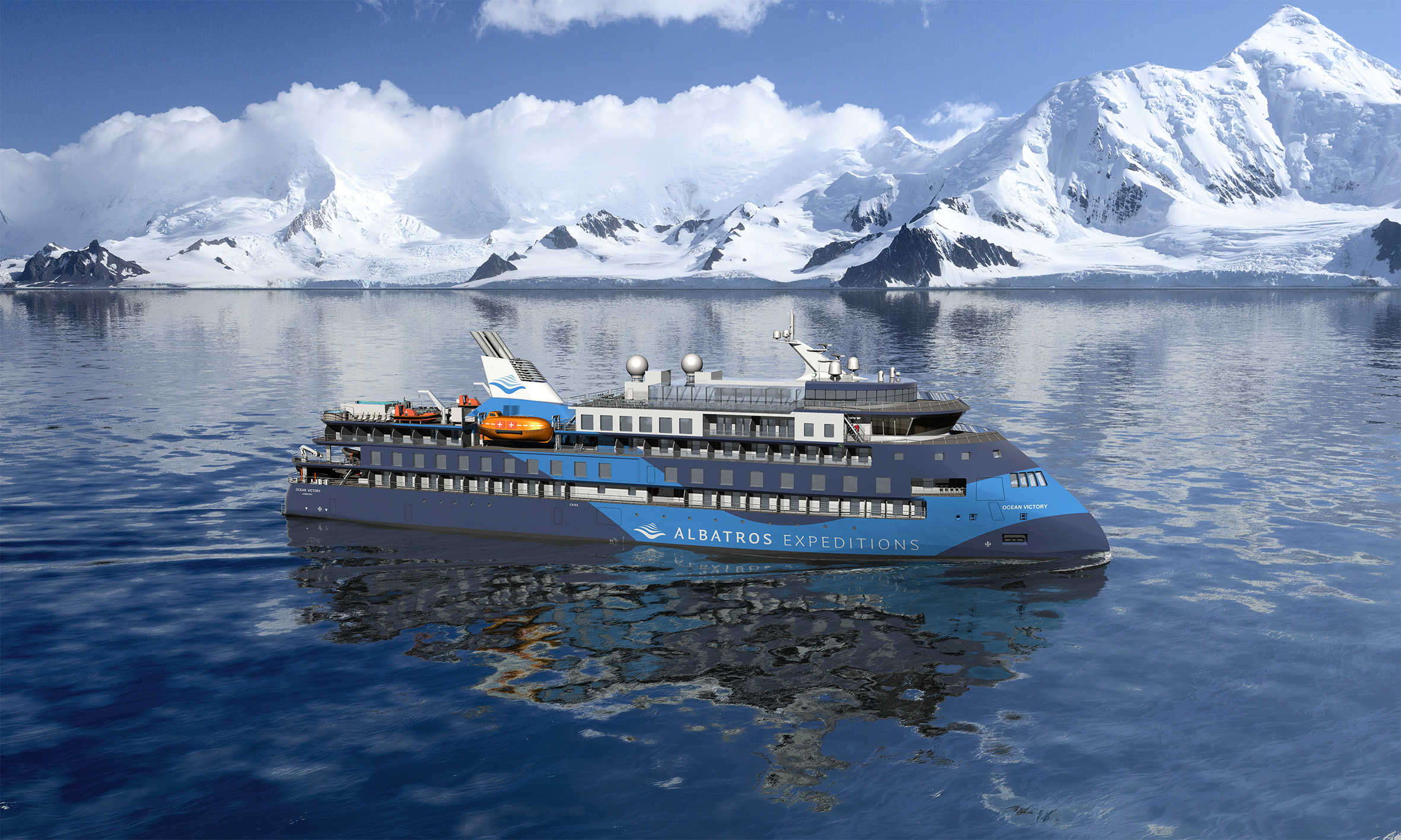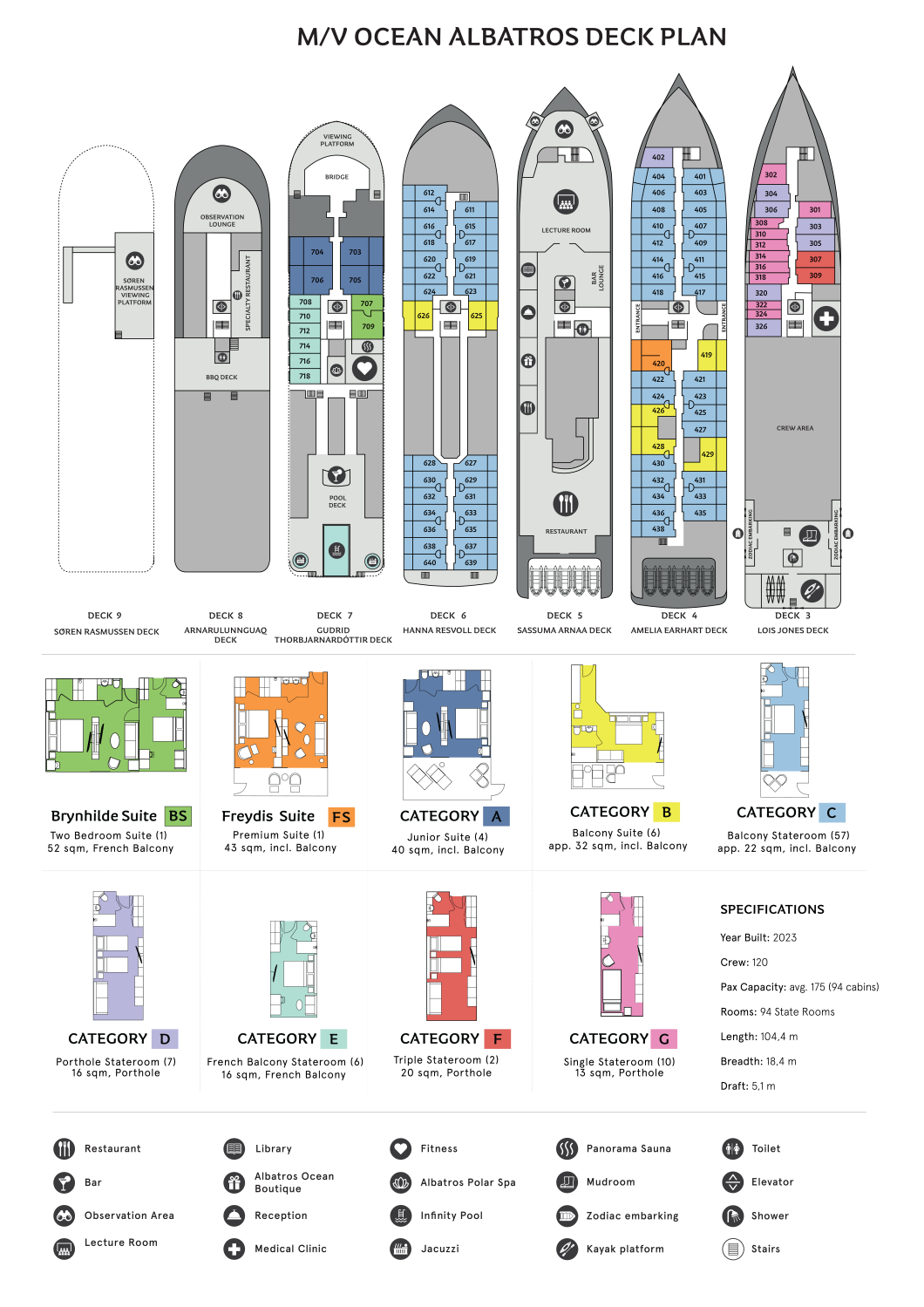Iceland to Svalbard: Ocean Albatros
North Atlantic
Embark at Reykjavik for a spectacular voyage towards the high Arctic. Along our way, land at an incredible three Arctic islands: Iceland (Grimsey), Jan Mayen, and Spitsbergen. Our first days will take us by the ragged cliffs of the Icelandic western and northern coasts. From here, we hope to make a call on the enigmatic volcano of Jan Mayen before we make landfall at the glaciated islands of Svalbard. The air is filled with migrating birds – and the sun never sets. We will scout for sea mammals and even seal-hunting polar bears on the pack ice
- Iceland’s West Coast With Snaefellness
- Northern Iceland's Rugged Coast
- Siglufjordur And The Arctic Circle At Grimsey
- Jan Mayen, At The Foot Of The 2200 Metre Beerenberg Volcano
- Ny Ålesund And Ny London
- Former Whaling Station At Smeerensburg And Ytre Norskøya
Last-Minute Prices!!
Discounted rates as shown are less than half price - hurry while space lasts!
Stewart's Take
Magnificent scenery on some of the northernmost islands of the planet
Overview
Embark at Reykjavik for a spectacular voyage towards the high Arctic. Along our way, land at an incredible three Arctic islands: Iceland (Grimsey), Jan Mayen, and Spitsbergen. Our first days will take us by the ragged cliffs of the Icelandic western and northern coasts. From here, we hope to make a call on the enigmatic volcano of Jan Mayen before we make landfall at the glaciated islands of Svalbard. The air is filled with migrating birds – and the sun never sets. We will scout for sea mammals and even seal-hunting polar bears on the pack ice.M/V OCEAN ALBATROS

The brand-new luxury infinity vessel Ocean Albatros is one of the most modern small ship vessels in the world. This stylish cruise ship is ideally suited to small-ship expeditions, with a total of 93 comfortable cabins for guests, all with a view of the ocean, 90% with a balcony, even a suite with a French balcony! Ocean Albatros is deployed and dedicated to varied Arctic polar voyages. With the highest Polar code 6 and Ice class 1A, Ocean Victory is the ideal vessel for small-ship cruising due to her sturdy construction and X-BOW® – Infinity class, which provides high stability in rough weather and allows for the smoothest movements on high waves, and a Solas 2012 classification, which facilitates a safe return to port. The vessel will have more than a 50% lower carbon footprint than traditional expedition vessels and be one of the most environmentally friendly, implementing the Green Initiative Program, ensuring both absolute comfort and sustainability for our guests. Ocean Albatros will also offer a unique panorama sauna, and a total of 12 dedicated solo travel cabins without a single-supplement. Like it's sistership the Ocean Victory it offers two restaurants, a wellness area, an Albatros Nordic Bar, an open deck dining facility, a modern lecture lounge, and other state-of-the-art amenities.

- 12-day/11-night cruise on Ocean Albatros in a shared outside double stateroom with a private bathroom in the category chosen
- Flight: Longyearbyen-Oslo
- Local transport in Longyearbyen on day 12
- English-speaking expedition staff
- Near-port walks with the expedition team
- Nature hikes and Zodiac cruises per itinerary
- Information briefings and lectures by the expedition team
- Special photo workshop
- Full board on the ship
- Dinner drink package
- Free coffee, tea, and afternoon snacks on the ship
- Welcome and farewell cocktails
- Taxes, tariffs, and landing fees
- Digital visual journal link after the voyage, including voyage log, gallery, species list, and more
- International flight to Aberdeen
- Extra excursions and activities not mentioned in the itinerary
- Single room supplement and cabin upgrades
- Meals not on board the ship
- Beverages (other than coffee and tea and dinner-drink package)
- Tips for the crew (we recommend USD 14 per person per day)
- Personal expenses
- Transfer to the ship in Reykjavik
- Travel, cancellation, and senior insurance
- Anything not mentioned under ’Inclusions’

Tour Dossier
Iceland to Svalbard: Ocean Albatros

This 12 day voyage on luxury Ocean Albatros is the perfect chance to head north from Iceland and experience the Arctic early summer splendour
File Creation date: 2024-04-26 - for updated information and dates and prices see the following page:
http://expeditionsonline.com/tour/iceland-to-svalbard-ocean-albatros_396

Iceland to Svalbard: Ocean Albatros
Duration: 12 days
Location: North Atlantic
Available: June
Start: Reykjavik, Iceland
Finish: Longyearbyen (with flight to Oslo)

Highlights
- Iceland’s West Coast With Snaefellness
- Northern Iceland's Rugged Coast
- Siglufjordur And The Arctic Circle At Grimsey
- Jan Mayen, At The Foot Of The 2200 Metre Beerenberg Volcano
- Ny Ålesund And Ny London
- Former Whaling Station At Smeerensburg And Ytre Norskøya

Itinerary
Embark at Reykjavik for a spectacular voyage towards the high Arctic. Along our way, land at an incredible three Arctic islands: Iceland (Grimsey), Jan Mayen, and Spitsbergen. Our first days will take us by the ragged cliffs of the Icelandic western and northern coasts. From here, we hope to make a call on the enigmatic volcano of Jan Mayen before we make landfall at the glaciated islands of Svalbard. The air is filled with migrating birds – and the sun never sets. We will scout for sea mammals and even seal-hunting polar bears on the pack ice





Ship Information
M/V OCEAN ALBATROS

The brand-new luxury infinity vessel Ocean Albatros is one of the most modern small ship vessels in the world. This stylish cruise ship is ideally suited to small-ship expeditions, with a total of 93 comfortable cabins for guests, all with a view of the ocean, 90% with a balcony, even a suite with a French balcony! Ocean Albatros is deployed and dedicated to varied Arctic polar voyages. With the highest Polar code 6 and Ice class 1A, Ocean Victory is the ideal vessel for small-ship cruising due to her sturdy construction and X-BOW® – Infinity class, which provides high stability in rough weather and allows for the smoothest movements on high waves, and a Solas 2012 classification, which facilitates a safe return to port. The vessel will have more than a 50% lower carbon footprint than traditional expedition vessels and be one of the most environmentally friendly, implementing the Green Initiative Program, ensuring both absolute comfort and sustainability for our guests. Ocean Albatros will also offer a unique panorama sauna, and a total of 12 dedicated solo travel cabins without a single-supplement. Like it's sistership the Ocean Victory it offers two restaurants, a wellness area, an Albatros Nordic Bar, an open deck dining facility, a modern lecture lounge, and other state-of-the-art amenities.

Iceland to Svalbard: Ocean Albatros
For the latest, up-to-date departure dates and prices please refer to the tour page:
http://expeditionsonline.com/tour/iceland-to-svalbard-ocean-albatros_396
Included
- 12-day/11-night cruise on Ocean Albatros in a shared outside double stateroom with a private bathroom in the category chosen
- Flight: Longyearbyen-Oslo
- Local transport in Longyearbyen on day 12
- English-speaking expedition staff
- Near-port walks with the expedition team
- Nature hikes and Zodiac cruises per itinerary
- Information briefings and lectures by the expedition team
- Special photo workshop
- Full board on the ship
- Dinner drink package
- Free coffee, tea, and afternoon snacks on the ship
- Welcome and farewell cocktails
- Taxes, tariffs, and landing fees
- Digital visual journal link after the voyage, including voyage log, gallery, species list, and more
Excluded
- International flight to Aberdeen
- Extra excursions and activities not mentioned in the itinerary
- Single room supplement and cabin upgrades
- Meals not on board the ship
- Beverages (other than coffee and tea and dinner-drink package)
- Tips for the crew (we recommend USD 14 per person per day)
- Personal expenses
- Transfer to the ship in Reykjavik
- Travel, cancellation, and senior insurance
- Anything not mentioned under ’Inclusions’

General Terms and Conditions
Expeditions Online Newsletter
Sign up to be an Expeditions Online insider and receive info on exclusive deals, discounts and more!